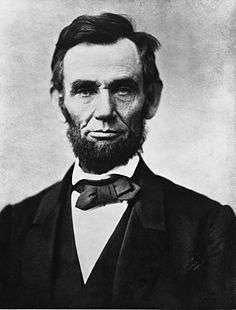Funeral and burial of Abraham Lincoln
| ||
|---|---|---|
|
President of the United States First term Second term Assassination and legacy
|
||
The funeral and burial of Abraham Lincoln included a three-week series of events in 1865 held to mourn the President's death and memorialize him. Following United States President Abraham Lincoln's death by assassination, funeral services were held in Washington, D.C., and then at additional locations as a funeral train transported his remains for burial in his hometown of Springfield, Illinois. The body was accompanied by dignitaries. Lincoln's eldest son Robert Todd rode the train to Baltimore and then disembarked and returned to the White House. Lincoln's wife Mary Todd Lincoln remained at the White House because she was too distraught to make the trip.[1] Robert took a later train to Springfield for his father's final funeral and burial.
The remains of Lincoln's youngest son, William Wallace Lincoln (1850–1862), were also placed on the train (see Movements of other Lincoln caskets below), which left Washington, D.C., on April 21, 1865 at 12:30 pm and traveled 1,654 miles (2,662 km) to Springfield, arriving on May 3, 1865. Several stops were made along the way, in which Lincoln's body lay in state. The train retraced the route Lincoln had traveled to Washington as the president-elect on his way to his first inauguration. Millions of Americans viewed the train along the route, and participated in the ceremonies and processions.
Lincoln was interred at Oak Ridge Cemetery in Springfield. The site of the Lincoln Tomb, now owned and managed as a state historic site, is marked by a 117-foot (36 m)-tall granite obelisk surmounted with several bronze statues of soldiers and sailors constructed by 1874. Mary Todd Lincoln and three of their four sons are also buried there. (Robert Todd Lincoln is buried in Arlington National Cemetery at Arlington, Virginia).[2] Because of the length of the funeral, historians have called this event "The Greatest Funeral in the History of the United States".[3]
Washington, D.C.
After the assassination of Abraham Lincoln by John Wilkes Booth, his body was carried by an honor guard to the White House on Saturday April 15, 1865. He lay in state in the East Room of the White House which was open to the public on Tuesday, April 18. On April 19, a funeral service was held and then the coffin, attended by large crowds, was transported in a procession down Pennsylvania Avenue to the Capitol Rotunda, where a ceremonial burial service was held. The body again laid in state on the 20th and on the early morning of the following day a prayer service was held for the Lincoln cabinet.[4]
Funeral train to Springfield, Illinois
At 7 a.m. on Friday, April 21, the coffin was taken by honor guard to the depot. Edwin M. Stanton, Gideon Welles, Hugh McCulloch, John Palmer Usher, Lieutenant General Ulysses S. Grant, and Montgomery C. Meigs left the escort at the depot, and at 8 A.M. the train departed. At least 10,000 people witnessed the train's departure from Washington.

The funeral train consisted of nine cars, including a baggage and hearse car. Eight of the cars were provided by the chief railways over which the remains were transported; the ninth was the President's car, which had been built for use by the president and other officials, and contained a parlor, sitting room, and sleeping apartment. The car had been draped in mourning and contained the coffins of Lincoln and his son. Different locomotives were used on different stretches of the trip. The train was preceded [10 minutes ahead] by a pilot locomotive with one car to see that the track ahead was unobstructed.
The Department of War designated the route and declared railroads over which the remains passed as military roads under the control of brevet Brigadier General Daniel McCallum, the director and superintendent of United States Military Railroads. No person was allowed to be transported on the cars except those authorized by the War Department, and the train never moved at speeds of more than 20 miles (32 km) an hour to avoid any accidents.
Five relatives and family friends were officially appointed to accompany the funeral train: David Davis, Associate Justice of the Supreme Court of the United States; Lincoln's brothers-in-law, Ninian Wirt Edwards and C. M. Smith; Brigadier General John Blair Smith Todd, a cousin of Mary Todd Lincoln; and Charles Alexander Smith, the brother of C. M. Smith. An honor guard accompanied the train; this consisted of Union Army Major General David Hunter; brevet Major General John G. Barnard; Brigadier Generals Edward D. Townsend, Charles Thomas Campbell, Amos Beebe Eaton, John C. Caldwell, Alfred Terry, George D. Ramsey, and Daniel McCallum; Union Navy Rear Admiral Charles Henry Davis and Captain William Rogers Taylor; and Marine Corps Major Thomas H. Field.
Four accompanied the train in an official capacity: Captain Charles Penrose, as quartermaster and commissary of subsistence; Ward Hill Lamon, Lincoln's longtime bodyguard and friend and U.S. Marshal for the District of Columbia; and Dr. Charles B. Brown and Frank T. Sands, embalmer and undertaker, respectively.[5]
Governor Oliver P. Morton of Indiana; Governor John Brough of Ohio; and Governor William M. Stone of Iowa accompanied the train with their aides.[5]
Lincoln's funeral train was the first national commemoration of a president's death by rail. Lincoln was observed, mourned, and honored by the citizens of Washington, Maryland, Pennsylvania, New York, Ohio, Indiana, and Illinois in the following cities:
| City | Arrive | Lying in state
in |
Public viewing
from / until |
Depart | Image |
|---|---|---|---|---|---|
| Washington, D.C. | Remark #1 | East Room, White House | public viewing: April 18, 1865: 9:30 a.m. / 5:30 p.m. &
private viewing: April 18, 5:30 p.m. / 7:30 p.m. |
 | |
| Remark #2 | United States Capitol rotunda | April 20, 1865: 8 a.m. / all day | April 21, 1865: 8 a.m. | ||
| Baltimore, Maryland | April 21, 1865: 10 a.m. | Merchant's Exchange Building | April 21, 1865: noon / 2 p.m. | April 21, 1865: 3 p.m. | 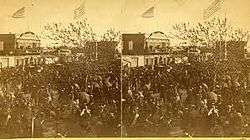 |
| Harrisburg, Pennsylvania | April 21, 1865: 8:30 p.m. | Pennsylvania State Capitol | April 21, 1865: until midnight &
April 22, 1865: 7 a.m. / 9 a.m. |
April 22, 1865: 11:15 a.m. | 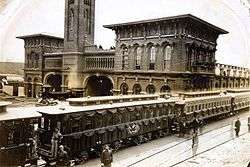 |
| Philadelphia, Pennsylvania | April 22, 1865: 4:50 p.m. | Independence Hall | private viewing: April 22, 1865: 10 p.m. / April 23, 1865: 1 a.m. &
public viewing: April 23, 1865: 6 a.m. / April 24, 1865: 1.17 a.m. |
April 24, 1865: 4 a.m. | 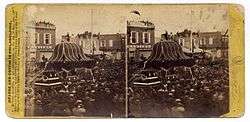 |
| New York City | April 24, 1865: 10:50 a.m. | City Hall | April 24, 1865: 1 p.m. / April 25, 1865: 11.40 a.m | April 25, 1865: 4:15 p.m. | 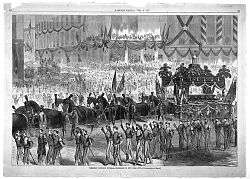 |
| Albany, New York | April 25, 1865: 10:55 p.m. | Old Capitol | April 26, 1865: 1:15 a.m. / 2 p.m.. | April 26, 1865: 4 p.m. | 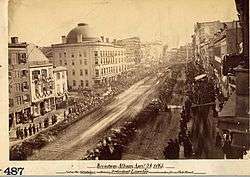 |
| Buffalo, New York | April 27, 1865: 7 a.m. | St. James Hall | April 27, 1865: 10:00 a.m. / 8 p.m. | April 27, 1865: 10 p.m. | 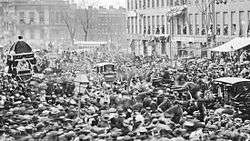 |
| Cleveland, Ohio | April 28, 1865: 6:50 a.m. | Monument Square | April 28, 1865: 10:30 a.m. / 10 p.m. | April 29, 1865: Midnight | |
| Columbus, Ohio | April 29, 1865: 7 a.m. | Ohio Statehouse | April 29, 1865: 9:30 a.m. / 6 p.m. | April 29, 1865: 8 p.m. | 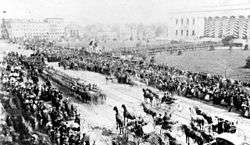 |
| Indianapolis, Indiana | April 30, 1865: 7 am | Indiana Statehouse | April 30, 1865: 9 a.m. / 10 p.m. | May 1, 1865: Midnight | |
| Michigan City, Indiana | May 1, 1865: 8 a.m. | Remark #3 | May 1, 1865: 8:35 a.m. | ||
| Chicago, Illinois | May 1, 1865: 11 a.m. | Old Chicago Court House | May 1, 1865: 5 p.m. / May 2, 1865: 8 p.m. | May 2, 1865: 9:30 p.m. | 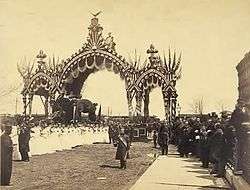 |
| Springfield, Illinois | May 3, 1865: 9 a.m. | Old State House | May 3, 1865: 10 a.m / May 4, 1865: 10 a.m. | Arrival Oak Ridge Cemetery: May 4, 1865: 1 p.m. |  |
The train passed 444 communities in 7 states (Lincoln was not viewed in state in the state of New Jersey).
- Remarks
- Remark #1: April 15–19, 1865: body of the deceased president in the White House; shortly after 9 o'clock Saturday morning (April 15, 1865) the remains were placed in a temporary coffin, under the direction of undertaker Frank T. Sands, and removed to the White House, six young men of the quartermaster's department carrying the body. An escort of cavalry Union Light Guard, under the command of Lieutenant James B. Jameson, accompanied the remains, which were followed by Generals Augur, commanding Department of Washington; Rucker, depot quartermaster, Colonel Pelouze, of the War Department, Captain Finley Anderson, A.A.G. Hancock's corps, Captain D.G. Thomas, clothing depot, Captain J.H. Crowell and Captain C. Baker, all walking bareheaded. The hearse moved slowly up 10th street to G, and thence to the White House (east gate).[6] The martyred president's autopsy was performed in a second floor guest room by army pathologist J. Janvier Woodward and his assistant Edward Curtis; also present: Surgeon General Dr. Joseph K. Barnes, Dr. Robert King Stone, Dr. Charles Sabin Taft, General Dr. Charles H. Crane, assistant surgeon William Morrow Notson, General Rucker and Lincoln's friend Orville H. Browning. After the autopsy Lincoln's body was brought (Monday evening, April 17) to the great East Room; the room was draped with crape and black cloth, relieved only here and there by white flowers and green leaves. The catafalque upon which the casket lay was about fifteen feet high, and consisted of an elevated platform resting on a dais and covered with a domed canopy of black cloth which was supported by four pillars, and was lined beneath with fluted white silk... From the time the body had been made ready for burial until the last services in the house, it was watched night and day by a guard of honor, the members of which were one major-general, one brigadier-general, two field officers, and four line officers of the army and four of the navy. The room was darkened — a sort of chapelle ardente. April 19: a short service was held in the Green Room
_(3252915551).jpg)
- Remark #2: April 19–21, 1865: lying in state in the U.S. Capitol rotunda. Arrival: April 19, 1865, 3 p.m. The procession started from the White House at 2 p.m. and proceeded up Pennsylvania Avenue to the Capitol amidst the tolling of bells and the firing of minute-guns. The funeral car was large. The lower base was fourteen feet [4.2 m] long and seven feet [2.1 m] wide, and eight feet [2.4 m] from the ground. The upper base, upon which the coffin rested, was eleven feet [3.4 m] long and five feet [1.5 m] below the top of the canopy. The canopy was surmounted by a gilt eagle, covered with crape. The hearse was entirely covered with cloth, velvet, crape and alpaca. The seat was covered with cloth, and on each side was a splendid lamp. The car was fifteen feet [4.6 m] high, and the coffin was so placed as to afford a full view to all spectators. It was drawn by six gray horses, each attended by a groom. The avenue was cleared the whole length... The sound of muffled drums was heard, and the procession, with a slow and measured tread, moved from the home of mourning on its mission with the remains of the illustrious dead. Despite the enormous crowd the silence was profound. The funeral car was carried up the steps of the Capitol, beneath the very spot where, six weeks before, the -now deceased- president had delivered his second Inaugural, and into the rotunda, where the body was removed from the car to another catafalque, where a service was read. Here the procession dispersed, leaving the remains of the president in the rotunda, where they were open to view the next day—The public viewing started April 20, 1865 (early morning)-- Depart from U.S. Capitol: April 21, 1865, 7 a.m.; coffin moved to Washington's Baltimore & Ohio Railroad Depot
- Remark #3: Michigan City, Ind. was a 35 min. stop; Lincoln's funeral train was forced to wait here for a committee of more than one hundred important men from Chicago, who were coming out to escort the train into their city; citizens of Michigan City held an impromptu funeral (patriotic organizations conducted memorial services and 16 young women were permitted to enter the funeral car; flowers were placed on the coffin) --

Burial site selection
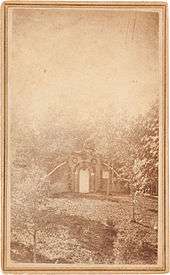
Shortly after Lincoln's death, a delegation of Illinois citizens (later forming the National Lincoln Monument Association) asked Mrs. Lincoln to return her husband's remains to Springfield for burial. She agreed, and the group then researched various sites in and around Springfield, selecting a centrally located, hilltop site known as Mather Block, and a temporary receiving vault was built there. However, Mrs. Lincoln selected Oak Ridge Cemetery for her husband's burial. Despite repeated attempts by the association to change the location of the burial to Mather Block, she remained firm in her decision.[7]
Springfield's choice: The Mather Vault
A large number of Illinois politicians were in Washington when Lincoln was assassinated, including the Governor, Richard J. Oglesby, a close friend of Lincoln. A few hours after Lincoln's death they met in Sen. Richard Yates' room at the National Hotel, to arrange a burial in Springfield, Illinois. Governor Oglesby was selected to confer with the Lincoln family on a burial place. Informal conferences were held on April 16. Mary Lincoln was not receiving visitors, but she preferred Chicago or the empty crypt in the U.S. Capitol that had been prepared for George Washington. She finally relented when her son Robert Todd Lincoln was able to persuade her to allow a Springfield burial, by promising to take Willie Lincoln's body along.
Springfield wanted a prominent burial location, a location that would draw visitors into downtown Springfield. A 6-acre (24,000 m2) block, owned by the family of Col. Thomas Mather, was selected, a plot that could be seen from the major railroad line (Chicago and Alton Railroad), a plot in the center of Springfield on a hill. Fifty thousand dollars were donated for the purchase and the work of constructing a temporary vault started immediately. The vault was designed to be a resting place for the remains until a grand monument could be erected. By men working night and day, through sunshine and rain, it was ready for use on May 24 (the day of the burial), although the work was not quite completed on the outside.
The Mather Block of land was later used as the site of the Illinois State Capitol building.[8]
Mary Lincoln's choice: Oak Ridge Cemetery
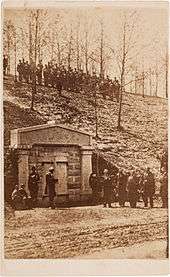
Mary Lincoln however recalled that Lincoln once had said that he wanted a quiet place for his burial at Oak Ridge (said to her on May 24, 1860, when Lincoln, then running for president, and Mary attended the dedication of Oak Ridge, a rural quiet cemetery, two miles (3 km) from the heart of Springfield). On April 28 Mary sent a message to Secretary of War Edwin M. Stanton, in which she stated that her decision was final and that Lincoln's remains must be placed in the Oak Ridge Cemetery. On April 29 another message followed: "arrangements for using the Mather vault must be changed." And on May 1 the message was: "the remains of the president should be placed in the vault of Oak Ridge and nowhere else." The Oak Ridge vault was readied, but work on the Mather vault continued as a "contingency." [9]
Even after the burial, the debate was not over. The National Lincoln Monument Association began again to stoke the fires of creating the grand tomb for Lincoln at the Mather Block. Mary Lincoln threatened to have her husband's remains taken to Chicago or Washington for permanent burial. "My determination is unalterable," she wrote on June 10 and demanded a formal promise that "the immortal Savior and Martyr for Freedom" would be at Oak Ridge, and imposed a deadline of June 15 before she would make good on her threat. The association voted, on the evening before the deadline, by the narrowest of margins, 8-7, to accept her demands. Oak Ridge Cemetery became the site of the Lincoln Tomb.
Attempted theft
When the tomb was completed in 1874, Lincoln's coffin was placed in a white marble sarcophagus in a burial room behind only a steel gate locked with a padlock, where he remained undisturbed for two years. In November 1876, Irish crime boss James "Big Jim" Kennally, who ran a counterfeiting ring in Chicago, decided on a plan for the release of his engraver, Benjamin Boyd, who had been arrested a year before and sentenced to ten years at the Illinois State Penitentiary in Joliet. The plan was to steal Lincoln's body from its tomb, bury it in the Indiana Dunes along Lake Michigan to cover their tracks, and hold it for ransom, in exchange for a full pardon for Boyd and $200,000 ($4,255,319 in 2012 dollars) in cash.[10][11]
To that end, Kennally recruited two members of his gang, Terrence Mullen and Jack Hughes, to carry out the plot. As they discussed their plans at "the Hub", a saloon owned by Kennally and Mullen on Madison Street in Chicago, they realized that neither had any experience with bodysnatching, and so they recruited a third man, Lewis Swegles, to assist them; Swegles brought in a man named Billy Brown as the getaway driver.[10] Their plan was to journey to Springfield on the overnight train on November 6, scout out the tomb on the day of November 7, and take the body that evening, while the people's attention was on the presidential elections.[10] None of them had any experience with lock-picking, so they had to cut through the padlock with a file. They then opened up the sarcophagus, but were unable to move the 500-pound, lead-lined cedar coffin more than a few inches. Mullen and Hughes sent Swegles to retrieve the wagon, but instead Swegles tipped off the waiting law enforcement officials in the vestibule of the tomb; Swegles and Brown were in fact paid informants of the United States Secret Service (at the time intended to stop counterfeiting, not protect the President). Swegles had gone to Patrick D. Tyrrell, the Secret Service chief in Chicago, when he received word of the plot.[11] As the lawmen moved in, one of the Pinkerton detectives present accidentally discharged his pistol, causing Mullen and Hughes to flee back to the Hub in Chicago. They were arrested by Tyrrell and his agents the following evening.[10]
The Lincoln Guard of Honor
After the foiled theft, tomb custodian John Carroll Power was concerned at how close the amateurs had come to stealing the body, and worried what would happen if professional graverobbers made a similar attempt to steal Lincoln's body. Thus, Power and a select group of trusted confidants elected to hide Lincoln's coffin in the basement of the tomb, the location known only to them.[11] Initially trying to dig a grave in the basement, they found that water seeped in wherever they dug, so they simply set the coffin on the ground and covered it with bits of lumber left over from the tomb's construction, disguising the coffin as a woodpile. Two years later, they managed to find a dry corner in another part of the tomb basement to bury the coffin under a few inches of dirt.[10]
On February 12, 1880, on what would have been Lincoln's 71st birthday, Power and his associates formed the "Lincoln Guard of Honor," to serve as the custodians of Lincoln's body, keeping the President's remains hidden. The only person outside of their inner circle who knew of their efforts was Lincoln's last surviving child, Robert Todd Lincoln. In July 1882, after Mary Todd Lincoln died, Robert instructed the Guard of Honor to bury his mother's coffin wherever they kept his father's. They remained in the basement until 1887, when they were encased in a brick vault. To ensure Lincoln's remains were still there, the coffin was opened by the Guard of Honor, who saw that indeed it was Lincoln in the coffin.[10]
Tomb reconstruction and exhumation
The original tomb was in constant need of repair and deteriorated significantly due to construction on unsuitable soil. In 1900, a complete reconstruction of Lincoln's tomb was undertaken, and the Lincolns' remains were exhumed, before Lincoln was finally placed back in the white marble sarcophagus that Mullen and Hughes had opened so easily in 1876.[10] In April 25, 1901, upon completion of the reconstruction, Robert Todd Lincoln visited the tomb. He was unhappy with the disposition of his father's remains and decided that it was necessary to build a permanent crypt for his father. Lincoln's coffin would be placed in a steel cage 10 feet (3.0 m) deep and encased in concrete in the floor of the tomb. On September 26, 1901, Lincoln's body was exhumed so that it could be re-interred in the newly built crypt. However, those present (a total of 23 people) feared that his body might have been stolen in the intervening years, so they decided to open the coffin and check.[12]
Last viewing
It was said that a harsh choking smell arose when the casket was opened. Lincoln was perfectly recognizable, even more than thirty years after his death. His face was a bronze color from unhealed bruises, a result of contrecoup (injury on the opposite side of the head from point of impact) caused by the gunshot wound, which shattered the bones in his face and damaged the tissue. His hair, beard and mole were all perfectly preserved although his eyebrows were gone. His suit was covered with a yellow mold and his gloves had rotted on his hands. On his chest, they could see some bits of red fabric — remnants of the American flag with which he was buried, which had by then disintegrated. It was theorized that Lincoln had been embalmed so many times on board his funeral train that he had been practically mummified.
- One of the last living persons to see the body, a youth of 14 at the time, was Fleetwood Lindley (1887–1963), who died on February 1, 1963. Three days before he died, Lindley was interviewed and confirmed his observations.[13]
- Another man, George Cashman, claimed to be the last living person to have viewed the remains of Abraham Lincoln. In the last years of his life, George Cashman was the curator of the National Landmark in Springfield called "Lincoln's Tomb." He particularly enjoyed relating his story to the more than one million visitors to the site each year. Cashman died in 1979. His claim concerning the viewing of Abraham Lincoln's remains was later refuted when his wife, Dorothy M. Cashman, wrote a pamphlet titled "The Lincoln Tomb." On page 14, Mrs. Cashman wrote, "At the time of his death in 1963 Fleetwood Lindley was the last living person to have looked upon Mr. Lincoln's face."[12][14]
Second tomb reconstruction
A second, major reconstruction of the tomb was undertaken in 1930-31. Much deterioration had occurred due to poor construction during the 1900–1901 reconstruction. During the second reconstruction, the entrance to the tomb was reconfigured to better accommodate visitors and the original, white marble sarcophagus was replaced with the red granite marker in front of the place where Lincoln is interred. Souvenir hunters destroyed the original sarcophagus, which was placed outside the tomb during reconstruction. The tomb was rededicated with President Herbert Hoover as the main speaker on June 17, 1931.[7]
One-hundred-and-fiftieth commemoration
During April and May 2015, groups including the National Park Service, commemorated the funeral and burial of Abraham Lincoln. In the Mountain West in the state of Idaho, the Idaho Civil War Sesquicentennial Commission, together with former Idaho Lt Governor and Attorney General David Leroy and the Idaho Civil War Volunteers, put together a special tribute "Idaho Remembers Lincoln" on April 15, 2015 on the Idaho State Capitol where flags were flown at half-mast that recreated the obsequies held in Springfield, Illinois on May 4, 1865 along with wreath-laying ceremonies at the 100-year-old Lincoln "Emancipator" statue, a 21-gun salute, civilian and military reenactors in period dress, speeches by David Leroy and Judge Steve Trott followed by a half-hour tolling of church bells in downtown Boise. In addition to the main event there was a free open house at the Idaho State archives where the permanent Lincoln exhibit: A.Lincoln: His Legacy in Idaho is permanently installed; and a special Idaho Civil War Round Table panel discussion with Skip Critell as Abraham Lincoln, Lincoln Bicentennial Commissioners K.C.Piccard and Frank Krone and train historian Eriks Garsvo from the Canyon County Historical Society who will talk about the funeral in Springfield and the Lincoln funeral train.[15][16][17]
Exhumation
Lincoln's coffin has been moved 17 times and the coffin opened 5 times.[18] Remark: the semi-circular Catacomb (or Burial Chamber) is at the north side of the base of the Lincoln Monument; on the south side (entrance) is Memorial Hall (or the Rotunda). Since the second reconstruction (1930 / 31) a connecting corridor leads into the Burial Chamber.
| Coffin placed | remarks | Coffin moved | Coffin opened |
|---|---|---|---|
| May 4, 1865 | Coffin placed in Receiving Vault, Oak Ridge Cemetery, Springfield, Ill. | December 21, 1865 | Yes |
| December 21, 1865 | Coffin placed in nearby special built Temporary Vault, Oak Ridge Cemetery. | September 19, 1871 | Yes |
| September 19, 1871 | Coffin placed in Lincoln Tomb (still under construction then), in temporary crypt in south wall Catacomb. The original walnut outer coffin is replaced by a new iron coffin. | October 9, 1874 | Yes |
| October 9, 1874 | Coffin placed in (white marble) sarcophagus in Catacomb, Lincoln Tomb. It is found that the iron coffin is too large to fit into the sarcophagus, so it is replaced with a new red cedar coffin. Lincoln Tomb was dedicated Oct 15, 1874. | November 7, 1876 | |
| November 7, 1876 | Coffin partly lifted from sarcophagus during an attempted theft. The thieves only moved the coffin 18 inches [45 cm] when they were interrupted by police. | November 9, 1876 | |
| November 9, 1876 | Coffin replaced in sarcophagus, which was then closed and sealed. | November 13, 1876 | |
| November 13, 1876 | Coffin removed (daytime) to place near northwest wall Catacomb, to be transported later that day. | November 13, 1876 | |
| November 13, 1876 | Coffin removed (nighttime) to secret location (eastside Lincoln Tomb, inside, near the base of the obelisk). | November 14, 1876 | |
| November 14, 1876 | Coffin placed into wooden case at the secret location (eastside Lincoln Tomb, near the inside base of the obelisk). | November 18, 1878 | |
| November 18, 1878 | Coffin replaced to another secret location (northside Lincoln Tomb, near the inside base of the obelisk). | November 20, 1878 | |
| November 20, 1878 | Lincoln was exhumed and reburied at same secret location (northside Lincoln Tomb) in response to an anonymous threat, received by the caretaker of the tomb via a postcard. The coffin was untouched in the grave in which it was placed a mere two nights before. | April 14, 1887 | |
| April 14, 1887 | Coffin removed to Memorial Hall for identification. | April 14, 1887 | Yes |
| April 14, 1887 | Coffin placed in newly built vault beneath floor of the Catacomb, Lincoln Tomb. After the coffins (of Lincoln and his wife) were lowered into the vault, it was filled with cement nearly in a liquid state, which in a short time hardened as a solid mass of stone, more than four feet and a half in depth over the top of the coffins. Over that the tessellated marble floor was relaid, and the sarcophagus placed in the original position. | March 10, 1900 | |
| March 10, 1900 | Coffin removed to a temporary vault dug into the hillside behind the monument (i.e. a secret place a few yards northeast of Lincoln's Tomb) during tomb reconstruction, which started in 1899 and lasted 15 months.[19] | April 24, 1901 | |
| April 24, 1901 | Coffin removed to reconstructed Lincoln Tomb. | July 10, 1901 | |
| July 10, 1901 | Coffin temporary removed to empty crypt in the southwall of the Catacomb in order to build a permanent crypt under the floor of the Catacomb. | September 26, 1901 | |
| September 26, 1901 | Coffin brought to and opened in Memorial Hall, for identification | September 26, 1901 | Yes |
| September 26, 1901 | Coffin permanently placed in a steel cage, and embedded in concrete, 10 feet (3.0 m) deep under the floor of the Catacomb. The sarcophagus in front of the place where Lincoln is finally interred is empty. The original white marble sarcophagus was replaced in 1931 by the present red granite marker. It was not necessary to move Lincoln's body in the 1931 construction, because the cenotaph was placed 6 feet (1.8 m) and thirty inches (76.2 cm) south from the inside north wall, with foundation as low as that of Lincoln's grave. |
Movements of other Lincoln caskets
On May 4, 1865, (Lincoln's arrival at Oak Ridge Cemetery, nineteen days after his death) another coffin, containing the body of Lincoln's son William "Willie" Wallace Lincoln (eleven), was placed with Lincoln's in the Receiving Vault. Willie, born December 21, 1850, died February 20, 1862 in the White House and was first interred (February 24, 1862) in the Carroll family tomb at the Oak Hill Cemetery in Georgetown. The casket bearing his remains was carried to Springfield on the funeral train of the assassinated president.
On December 21, 1865, the two caskets were moved to the temporary vault, halfway up the hillside, where the Lincoln Tomb was in construction at the top of the hill. The body of Lincoln's son Edward "Eddie" Baker Lincoln (three years, ten months) was already placed there on Dec. 13, 1865. Eddie, born March 10, 1846, died February 1, 1850 and was first buried at the Hutchinson Cemetery, Illinois. The three bodies rested in the temporary vault while the Lincoln tomb was being built. The three bodies were moved to the catacomb of the tomb on September 19, 1871. They were not the first. Two months earlier (on July 17, 1871) it was Lincoln's son Thomas ("Tad") Lincoln, born April 4, 1853, who was the first Lincoln placed into a crypt in the Lincoln Tomb. Tad died on July 15, 1871, in Chicago, Illinois, aged eighteen.
Lincoln's wife, Mary Todd Lincoln, born December 13, 1818, died July 16, 1882. She was buried July 19, 1882, in one of the family crypts in the Lincoln Tomb. In the night of July 21, 1882, Mary Todd's casket was secretly taken from the crypt and at Robert Todd Lincoln's (her eldest son) request, buried alongside the President. On April 14, 1887, both caskets were moved to Memorial Hall.
Lincoln's grandson Abraham Lincoln II ("Jack"), born August 14, 1873, died March 5, 1890, in London and was temporarily buried in Kensal Green Cemetery, London, until his father returned to the U.S. with his body and on November 8, 1890, was placed in one of the crypts in the Lincoln Tomb. His body remained in the tomb until May 27, 1930, when he was re-interred at the family plot of his father, Robert Todd Lincoln (August 1, 1843, to July 25, 1926), at Arlington National Cemetery in Virginia.
During the first Lincoln Tomb reconstruction (1900–1901), the Lincoln family was disinterred and moved to the temporary vault northeast of the tomb. On April 24, 1901, the Lincoln family was removed from the temporary vault and placed back into the Lincoln Tomb.
While President Lincoln was finally at rest, the remainder of the Lincoln family was moved two more times. The coffins containing the bodies of Mary, Eddie, Willie, and Tad Lincoln were removed during the second tomb reconstruction (1930–1931) from their crypts and transported to the Oak Ridge mausoleum, located near the south gate of the cemetery. After the second reconstruction was completed, the bodies were returned to their crypts in June, 1931.
See also
- Chicago History Museum - holds clothing Lincoln wore the night he died, and the bed he died in.
- National Museum of Health and Medicine - On display are Lincoln's life mask, the bullet fired from the Derringer pistol used by John Wilkes Booth to assassinate the president, the probe used by the Army Surgeon General Joseph Barnes to locate the bullet, pieces of Lincoln's hair and skull, and the surgeon's shirt cuff, stained with Lincoln's blood.[20]
- The Henry Ford - On display is the chair in which Lincoln was shot.
- Lincoln Memorial - The Lincoln Memorial on the National Mall in Washington, D.C.
- Studebaker National Museum- On display is the "Lincoln carriage, used by President Lincoln to take him and his wife on his final ride to Ford's Theater on April 14, 1865. This treasured artifact is a permanent part of the Studebaker National Museum's collection"
References
- ↑ "The Route Of Abraham Lincoln's Funeral Train". Rogerjnorton.com. Retrieved 2010-11-29.
- ↑ "Abraham Lincoln's Tomb". Showcase.netins.net. Retrieved 2010-11-29.
- ↑ "Lincoln Highway National Museum & Archives-Lincoln Funeral Train Route". Lincoln-highway-museum.org. 2001-03-21. Retrieved 2010-11-29.
- ↑ "President Abraham Lincoln's White House Funeral". Abrahamlincolnonline.org. Retrieved 2015-05-29.
- 1 2 Lincoln memorial: The journeys of ... - Google Books. Books.google.com. 2006-08-10. Retrieved 2010-11-29.
- ↑ "Illustrated life, services, martyrdom, and funeral of Abraham Lincoln" by David Brainerd Williamson, T.B. Peterson & Brothers, Philadelphia, 1865
- 1 2 Nancy Hill. "The Transformation of the Lincoln Tomb". Historycooperative.org. Retrieved 2010-11-29.
- ↑ http://www.ilstatehouse.com/construction.htm
- ↑ Mark A. Plummer: Lincoln's rail-splitter: Governor Richard J. Oglesby, p. 109 / 110
- 1 2 3 4 5 6 7 "THE ATTEMPTED KIDNAPPING OF LINCOLN". Bits of Blue and Gray. May 2003. Retrieved 2012-09-04.
- 1 2 3 Thomas J. Craughwell (June 24, 2007). "A Plot to Steal Lincoln's Body". US News and World Reports. Retrieved 2012-09-04.
- 1 2 "Lincoln's Body Exhumed and Viewed in 1901". Rogerjnorton.com. Retrieved 2010-11-29.
- ↑ "Recalls Look at Lincoln's Face in Tomb". Chicago Tribune. February 4, 1962. Retrieved 2009-02-24.
"I saw his face," Fleetwood Lindley, 74, a retired florist, said. "It was September 26, 1901, in the Civil war Presidents tomb when a group of Springfield ...
- ↑ "Life magazine, 1963". Rogerjnorton.com. Retrieved 2010-11-29.
- ↑ "Lincoln's hometown gets ready for a most solemn re-enactment". Chicagotribune.com. 2015-03-31. Retrieved 2015-05-29.
- ↑ "Chicago part of Park Service's plan to mark Lincoln funeral train". Chicagotribune.com. 2015-04-07. Retrieved 2015-05-29.
- ↑ "Boise, Meridian, Nampa, Caldwell news by Idaho Statesman". Idahostatesman.com. Retrieved 2015-05-29.
- ↑ John Carroll Power, "History of an Attempt to Steal the Body of Abraham Lincoln" (1890)
- ↑ "REMAINS OF LINCOLN MOVED.; Transferred to a Vault Pending Rebuilding of Monument at Springfield, Ill.". The New York Times. March 11, 1900. Retrieved April 23, 2010.
- ↑ National Museum of Health and Medicine Exhibits at the Wayback Machine (archived July 2, 2007)
External links
- Lincoln Tomb State Historic Site - Lincoln Tomb Virtual Tour
- Pass to Lincoln's Funeral in the Executive Mansion Shapell Manuscript Foundation
